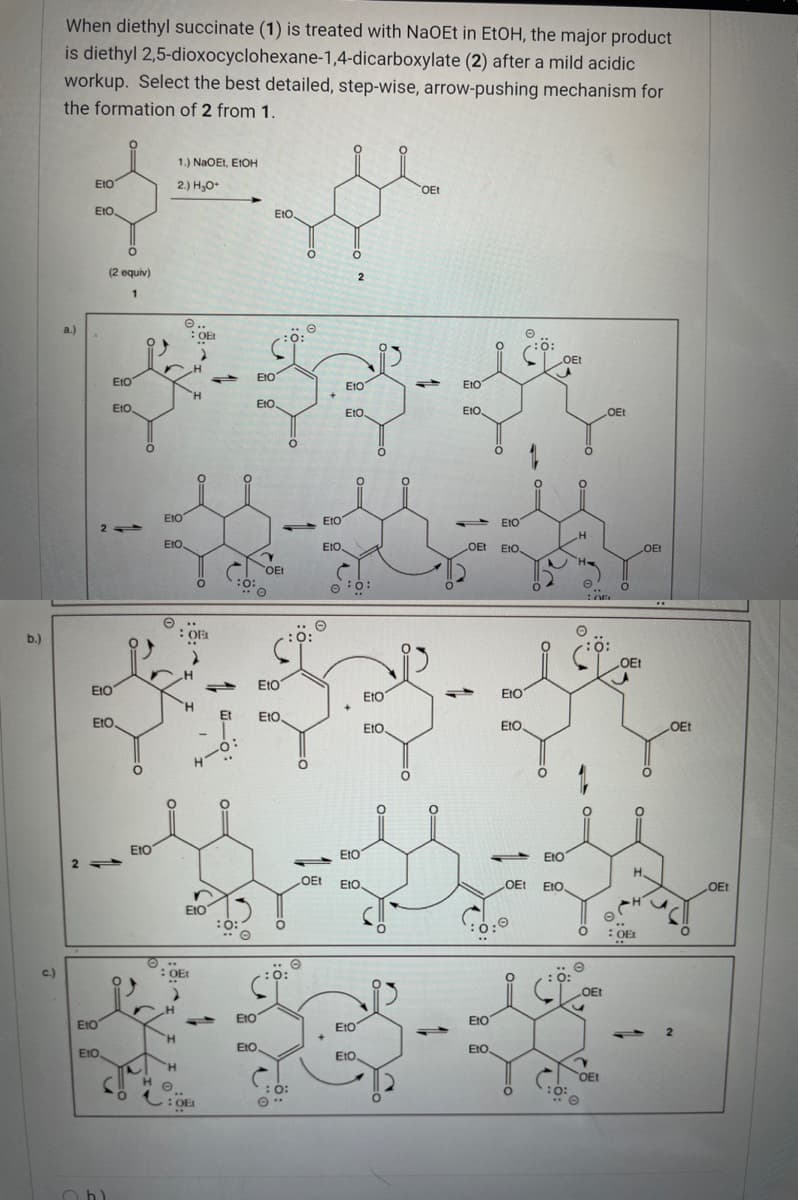When diethyl succinate (1) is treated with NaOEt in EtOH, the major product is diethyl 2,5-dioxocyclohexane-1,4-dicarboxylate (2) after a mild acidic workup. Select the best detailed, step-wise, arrow-pushing mechanism for the formation of 2 from 1. 1.) NaOEt, E1OH EtO 2.) H,0 OEt EtO, EtO, (2 equiv) .. a.) : OEt O: OEt EtO EIO EtO EtO H. EtO. EtO. EtO, E1O. EtO. OEt EIO EtO EIO 2 EtO EtO, OEt t EIO, OEt OE! :0: O .. OEL b.) :O: 0: OEt E10 EIO E1O EtO EtO Et EtO, EtO. EtO EtO Ot EtO EtO EtO H. OEt EtO. LOET EIO. OEt EIO EtO :o: OE c.) O .. COEt O: OEt EtO EIO E1O EtO H. EIO EtO. EtO. EtO H. OEt :O: H. : :OE 1.
When diethyl succinate (1) is treated with NaOEt in EtOH, the major product is diethyl 2,5-dioxocyclohexane-1,4-dicarboxylate (2) after a mild acidic workup. Select the best detailed, step-wise, arrow-pushing mechanism for the formation of 2 from 1. 1.) NaOEt, E1OH EtO 2.) H,0 OEt EtO, EtO, (2 equiv) .. a.) : OEt O: OEt EtO EIO EtO EtO H. EtO. EtO. EtO, E1O. EtO. OEt EIO EtO EIO 2 EtO EtO, OEt t EIO, OEt OE! :0: O .. OEL b.) :O: 0: OEt E10 EIO E1O EtO EtO Et EtO, EtO. EtO EtO Ot EtO EtO EtO H. OEt EtO. LOET EIO. OEt EIO EtO :o: OE c.) O .. COEt O: OEt EtO EIO E1O EtO H. EIO EtO. EtO. EtO H. OEt :O: H. : :OE 1.
Chemistry
10th Edition
ISBN:9781305957404
Author:Steven S. Zumdahl, Susan A. Zumdahl, Donald J. DeCoste
Publisher:Steven S. Zumdahl, Susan A. Zumdahl, Donald J. DeCoste
Chapter1: Chemical Foundations
Section: Chapter Questions
Problem 1RQ: Define and explain the differences between the following terms. a. law and theory b. theory and...
Related questions
Question

Transcribed Image Text:When diethyl succinate (1) is treated with NaOEt in EtOH, the major product
is diethyl 2,5-dioxocyclohexane-1,4-dicarboxylate (2) after a mild acidic
workup. Select the best detailed, step-wise, arrow-pushing mechanism for
the formation of 2 from 1.
1.) NaOEt, E1OH
EtO
2.) H,O
OEt
EtO,
EtO,
(2 equiv)
1
O..
: OE
a.)
O:
OEt
EtO
EIO
EtO
EtO
H.
EtO.
EtO.
E1O.
EtO.
OEt
EIO
EtO
EtO
2
EtO
EtO.
OEt
t EIO,
LOEt
OEt
O
:ö:
O ..
OEL
b.)
:O:
0:
OEt
E10
EIO
E1O
EtO
EtO
Et
EtO,
EtO
EtO
EtO
Ot
EtO
EtO
EtO
H.
OEt
EtO.
LOET
EIO.
OEt
EtO
:0:
OEt
O ..
COEt
c.)
O:
OEt
10
EIO
EIO
EtO
EtO
H
EIO
EtO
EtO,
EtO
H.
OEt
:O:
H.
O:
:OE
Expert Solution
This question has been solved!
Explore an expertly crafted, step-by-step solution for a thorough understanding of key concepts.
This is a popular solution!
Trending now
This is a popular solution!
Step by step
Solved in 2 steps with 2 images

Knowledge Booster
Learn more about
Need a deep-dive on the concept behind this application? Look no further. Learn more about this topic, chemistry and related others by exploring similar questions and additional content below.Recommended textbooks for you

Chemistry
Chemistry
ISBN:
9781305957404
Author:
Steven S. Zumdahl, Susan A. Zumdahl, Donald J. DeCoste
Publisher:
Cengage Learning

Chemistry
Chemistry
ISBN:
9781259911156
Author:
Raymond Chang Dr., Jason Overby Professor
Publisher:
McGraw-Hill Education

Principles of Instrumental Analysis
Chemistry
ISBN:
9781305577213
Author:
Douglas A. Skoog, F. James Holler, Stanley R. Crouch
Publisher:
Cengage Learning

Chemistry
Chemistry
ISBN:
9781305957404
Author:
Steven S. Zumdahl, Susan A. Zumdahl, Donald J. DeCoste
Publisher:
Cengage Learning

Chemistry
Chemistry
ISBN:
9781259911156
Author:
Raymond Chang Dr., Jason Overby Professor
Publisher:
McGraw-Hill Education

Principles of Instrumental Analysis
Chemistry
ISBN:
9781305577213
Author:
Douglas A. Skoog, F. James Holler, Stanley R. Crouch
Publisher:
Cengage Learning

Organic Chemistry
Chemistry
ISBN:
9780078021558
Author:
Janice Gorzynski Smith Dr.
Publisher:
McGraw-Hill Education

Chemistry: Principles and Reactions
Chemistry
ISBN:
9781305079373
Author:
William L. Masterton, Cecile N. Hurley
Publisher:
Cengage Learning

Elementary Principles of Chemical Processes, Bind…
Chemistry
ISBN:
9781118431221
Author:
Richard M. Felder, Ronald W. Rousseau, Lisa G. Bullard
Publisher:
WILEY